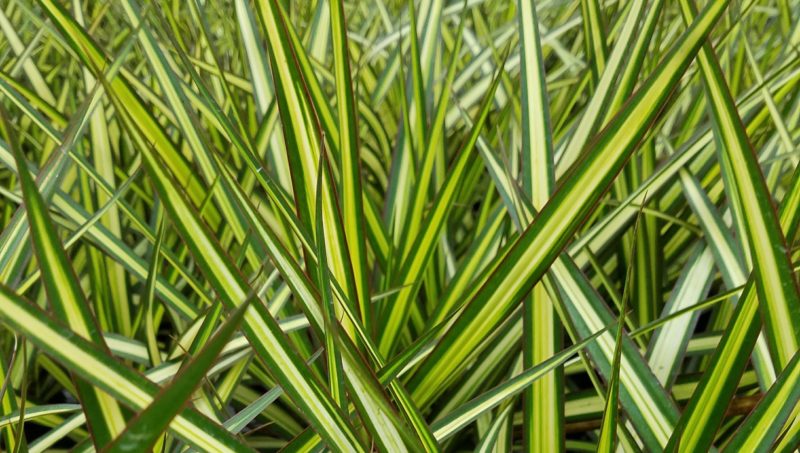
Let’s Talk Combo Pots
For years our industry has been utilizing combo pots for entryways and patios. The main accent centerpiece items have typically been a dracaena spike or fountain grass. Although they have their own merits, enough already! The trend has been moving into mixing up your combo pots with tropical plants. They can give some great new textures and colors to your patio pots, which often can be brought inside at the end of summer and maintained as a houseplant as the annual components retire away.
I wanted to review some alternative crops that can be utilized in your combos to add excitement to your mix. These are all suited to tolerate the full sun environment that your combos would normally be in.
ALOCASIA
Alocasia are a broad leaf tuberous perennial. They add nice large leaves and a good tropical feel to your combo pots. They are normally propagated from tissue culture (TC) and sold as liners. If you look around, the amount of different sizes and shapes that are available in this genus is enormous. This is one of the tropicals that has already gotten a good footing in the combo pot usage.
Liners are best brought in and planted into 6-inch pots (smaller for the smaller varieties). Grow the plants on for eight weeks and then
they will be ready to add into your combo pots.
DRACAENA MARGINATA
Dracaena work very well as an accent plant as well giving a much more formal and colorful look than the typical spikes. The main varieties available are Bicolor, Colorama, Magenta and Marginata. They are typically available from unrooted cuttings (URC), calloused cuttings or air layers. Liner trays can be produced from the smaller URC or calloused cuttings, while the air layers are best planted into a 6-inch pot. The liners will typically take about eight weeks to develop. The air layers will also take about eight weeks to fully fill in their roots in the 6-inch pot. It is also possible to plant the larger air layers directly into your finished combo pots for less handling.
CROTON
As discussed in a previous article, there are an incredible amount of different croton varieties. They are most utilized in fall combo pots as they give a nice fall color range of reds and yellows. Adding these into combos with chrysanthemums is as good of a match as chocolate and peanut butter, of course I am a Reese’s fanatic!
Crotons for combo pots can be rooted in liners and then transplanted into the finished container. For larger combos, you will want to grow them on in a 6-inch pot until they are two-thirds of the finished size you want for the finished container. Liners will typically need around eight weeks and an additional eight in the 6-inch if you want large plants.
PANDANUS DWARF VARIEGATED
I truly love this plant and due to the tropical environment at my home it has become a heavily planted item in my yard. Pandanus provide a beautiful green and yellow foliage plant that is very tolerant of hot, humid and sunny locations. They are typically available as a rooted cutting. Plants can be brought in and planted into 4-inch pots for, you guessed it, about eight weeks. At this point, they can be planted into your final combo pots to finish growing out. They can have a little sensitivity to Fusarium, so watch out for it. It can easily be managed with appropriate fungicide programs.
SCHEFFLERA
There are several commonly accessible varieties of Schefflera on the market. Their compound leaves with varying amounts of green and yellow make them an exciting accent for your combos. Depending on the variety, you have access to compact to large, making them useable in many different sized combos.
Just like the dracaena, they are available in URC, calloused cuttings, or air layers depending on the variety. Unlike the dracaena, they will need to be misted even in the air layers, until the roots have developed into the pots. The smaller varieties can easily be started in liners whereas the larger varieties will be best suited going into 6-inch pots. Liners from URCs as well as pots from air layers will both take about eight weeks to finish. From this point, they can be added into your combos for a summer full of unique leaf shapes you don’t normally get from your annual crops.
BANANA
Bananas are the other tropical that has already been used frequently in combo pots. They typically start from TC and are sold as a finished liner. To avoid them getting too dry to quickly, it is recommended to pot these up in a 4- or 6-inch pot first before planting into your combos. The 4-inch will take four to six weeks whereas the 6-inch will take six to eight depending on the variety. Most varieties will grow very quickly and will produce a large plant for you through the summer.
There is no need to stay stuck in the rut of dracaena spikes and fountain grass. There are many options available to spice up your combo pots with tropical plants. The trend of combination pots is continuing to grow larger and larger. The best way to maintain that momentum is to keep variety in the mix. Tropicals can play very nice together with your annuals, make sure to include them this coming spring.


 Video Library
Video Library 




















